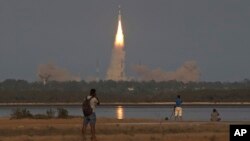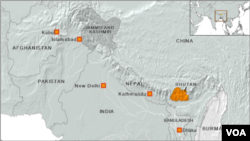India launched a "South Asia" satellite on Friday to provide communication services to neighboring countries in a new initiative hailed by leaders of seven South Asian countries as a boost to regional cooperation.
The "space diplomacy" by India, which has an advanced space program, aims at building stronger ties in the region where China has been gaining influence. But underlining the tensions between the two most populous countries in the region, India's arch-rival, Pakistan has opted out of the project.
Soon after the launch of the $70-million satellite, which is funded by New Delhi, the leaders of the seven countries participating in the project — India, Bangladesh, Nepal, Sri Lanka, Bhutan, Afghanistan and the Maldives, addressed a video conference that was nationally televised.
Calling it the "first of its kind" project, Indian Prime Minister Narendra Modi said the satellite would help meet the aspirations of economic progress of one-and-a-half-billion people in the region.
"It shows that our collective choices for our citizens will bring us together for cooperation, not conflict, development, not destruction, and prosperity, not poverty, he said."
Pointing out that South Asia was the world's least economically integrated region, Afghan President Ashraf Ghani said "South Asia has taken a giant step today toward regional cooperation."
The leader of the landlocked country, which does not have road access to India, said if cooperation through land is not possible, it is certainly possible through the sky. "We are confident we will integrate," he said.
Weighing 2,230 kilograms and containing 12 communication transponders, the satellite was put in orbit by a rocket in Sriharikota in eastern Andhra Pradesh state. It will help provide services such as telecommunications, telemedicine, disaster management and weather forecasting.
In a region prone to natural disasters like cyclones, floods and earthquakes, the satellite's greatest benefit is expected to be in the area of disaster management.
The biggest beneficiaries will be the two smallest countries — Bhutan and Maldives.
Bhutanese Prime Minister Tshering Tobgay noted that his tiny Himalayan country, which measures the happiness quotient of its citizens as an indicator of progress, had neither the technical know-how nor the resources to launch their own satellite. He said the satellite will "advance the well being and happiness of our people" as it helps boost an array of services.
Pointing out that India wants to use its space program to further its regional goals, Sukh Deo Muni, a South Asia expert at New Delhi's Institute of Defense Studies and Analyses said "India wants to take the lead in integrating the region, and probably join hands on the developmental issues, cooperating with each other."
After taking office in 2014, Prime Minister Modi launched what he called a "neighborhood first" approach, partly to counter China, which has expanded its influence in South Asia and pumped in billions of dollars to build infrastructure projects in countries like Sri Lanka.
Rajeswari Pillai Rajagopalan at the Observer Research Foundation Others said that for the first time, Modi is giving a strategic dimension to the country's space program.
"India is possibly beginning to appreciate the importance of space launches as part of foreign policy tool and diplomatic engagement, something that China has been doing for a long time," he said.
Foreign policy experts say Pakistan's decision to opt out of the project is not surprising given the deep political hostilities and suspicions between the two countries.






